What is Electric Current
Electric Charge and Electric Current
- What is an electric charge? Objects that exert electric forces are said to have electric charges. Electric charge is the source of electrical force.
- There are two types of electrical charges, positive (+) and negative (-). Two like charges (+ and + or – and -) repel each other. Two unlike charges (+ and -) attract each other.
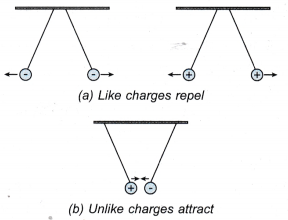
- The electric force between two charges is known as electrostatic force or Coulomb’s force.
- A Van de Graaff generator as shown in Figure is often used as a source of electrostatic charges in the laboratory. It can produce a large and continuous supply of electrical charges. It accumulates charges, produced by the contact between the roller and the rubber belt, onto the metal dome. While the belt is running, a very large concentration of charges can be built up.
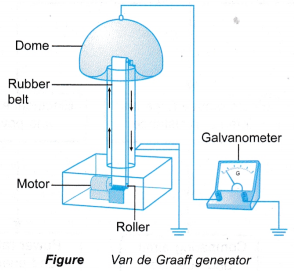
- If the charged metal dome is connected to the earth via a galvanometer, the pointer deflects, indicating that there is a flow of charges. This flow of electrical charges is known as electric current.
- Electric current is made up of flowing electrons. Each electron carries a negative charge of 1.6 x 10-19 C.
- Definition: The quantity of electric charge flowing through cross section of a given conductor in one second is called current. or Electric current is defined as the rate at which electric charges flow through a conductor.
Thus, if Q is the charge which flows through a conductor in time t, then the current (I) is given by
\(\text{Current }\left( \text{I} \right)\text{= }\!\!~\!\!\text{ }\frac{\text{Charge}\,\text{(Q)}}{\text{Time}\,\text{(t)}}\)
The electric current (or current) is a scalar quantity. - Unit of current
The SI unit of charge (Q) is coulomb (C), and that of time (t) is second (s). So, SI unit of current
\(=\frac{\text{I}\,\text{coulomb}}{\text{1second}}=1\text{ C }{{\text{s}}^{-1}}=1\text{ ampere (A)}\) - The unit coulomb per second (Cs-1) is called ampere (A).
- The current that flows through a conductor is said to be one ampere if one coulomb of charge flows past the conductor in one second.
People also ask
- What is an electric field and how is it created?
- What is the Relationship between Electric Current and Potential Difference?
- Electromotive Force, Internal Resistance & Potential Difference of a Cell/Battery
- How series and parallel circuits are different?
- Relationship between Energy Transferred, Current, Voltage and Time
- Power Rating and Energy Consumption of Various Electrical Appliances
Direction of Electric Current:
The direction of flow of the positive charge taken as conventional direction of the electric current.
When we consider the flow of electric current in an ordinary conductor, such as a copper wire, the direction of current is taken as opposite to the direction of the flow of electrons.
Most of the devices and machines we use like an electric iron, oven, room heater, refrigerator, ceiling fan or an electric bulb work when an electric current flows through them.
With help from an adult, look at what is inside a transparent electric bulb. Among other things, you will see that it has a thin filament (a very thin metal wire). The filament heats up when an electric current is passed through it. It heats up so much that it begins to glow and give out light.

Now, we will learn what produces an electric current.
Electric Current Example Problems with Solutions
- The electrical current supplied by a battery in a digital clock is 0.5 mA.
(a) What is the quantity of charges that flow in half an hour?
(b) Find the number of charges that flow through the clock.
[e = 1.6 x 10-19 C]
Solution:
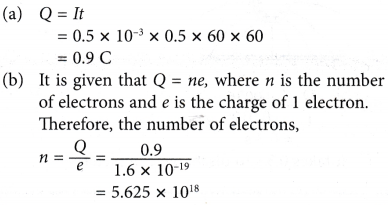
- A bulb is connected to a battery. The rate of charge flow passing through the bulb is 120 C per minute.
(a) What is the current that flows in the circuit?
(b) If the battery can supply a current of 2.0 A for 1 hour, for how long can the battery supply a continuous current of 4.0 A?
Solution:
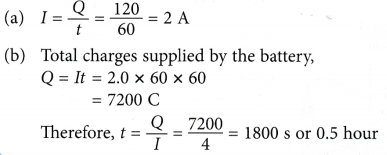
- Figure shows a positively-charged conducting sphere being suspended by a nylon thread. An earthed copper plate is placed not far below the conducting sphere.
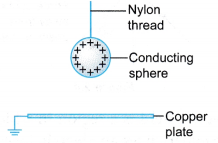
(a) Draw electric field lines around the conducting sphere and the region between the conducting sphere and the copper plate.
(b) The conducting sphere carries a charge of 0.0036 C. When a wire is used to connect the conducting sphere to the copper plate, it becomes completely discharged. The average current flow during the discharge is 0.012 A. How long does it take for the body to discharge completely?
Solution:
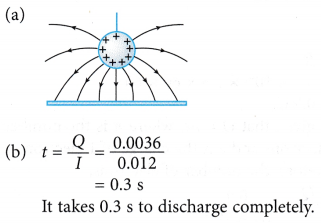
Source of electric current
A device that can be used to produce an electric current is called a source of electric current. Common sources of electric current are cells and batteries (collection of cells) which comes in various shapes and sizes, and electric current that we get from plug points in houses. A very useful kind of cell which we use very often is the dry cell. Due to a chemical reaction that takes place in cells and batteries, electric current is produced.
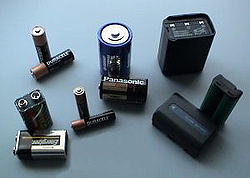
For large-scale production of electricity, flowing water or steam is used.
The Dry Cell
A dry cell is a very convenient source of electric current. The dry cell, as its name suggests, contains dry or semi-solid ingredients.
Let us take a look inside a dry cell.
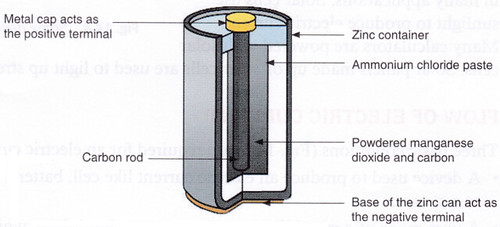

The dry cell contains a paste of ammonium chloride inside a zinc container. Inside the paste, a cardboard container containing powdered manganese dioxide and carbon is placed. The cardboard container has microscopic ‘holes’ in it (such materials are called porous materials) through which a chemical reaction takes place between ammonium chloride paste and powdered manganese dioxide. A rod, usually carbon, with a metal cap is dipped into the manganese dioxide. The whole thing is then sealed (with only the metal cap sticking out), so that the contents do not spill out. The zinc can is also wrapped so that only the base is exposed. Every source of electric current has two ends or terminals where conducting wires are connected to draw electric current. The tip of the metal cap and the base of the zinc can are called the positive and negative terminals of the dry cell, respectively. Electric current can be thought of as ‘flowing in’ from one terminal and ‘flowing out’ from the other. If the tip of the metal cap and the base of the zinc can are connected by a metal wire, current will flow through it.
Different Types of Electric Cells
Apart from the simple primary cells like dry cell, there are different types of electric cells. Different cells use different methods for producing an electric current. Primary cells can be used only once, and have to be thrown away once they have been used up.
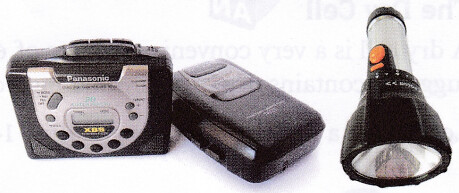
There are cells that can be recharged once they are drained. These are called secondary cells. They are used in mobile phones, laptops, and car batteries.
Nowadays, solar cells are being used in many applications. Solar cells use sunlight to produce electric current. Many calculators are powered with solar cells. Solar panels made up of solar cells are used to light up streets and many homes.